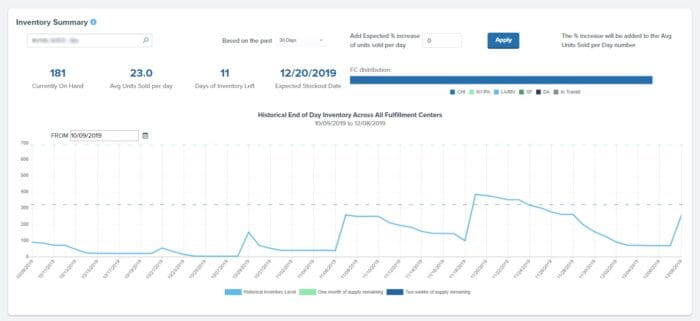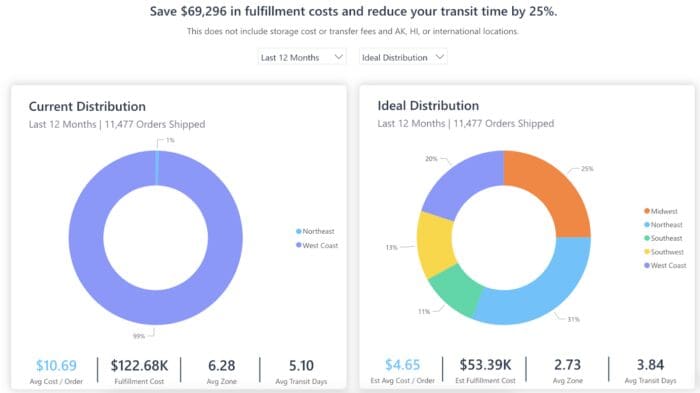Table of Contents
** Minutes
What is domestic distribution? Expert definition from ShipBob
Understanding domestic distribution processes in ecommerce
For ecommerce business owners, the time between checkout and delivery is key to making a great first impression with your customers. The further a package needs to travel, naturally, the longer it will take to receive.
But fast shipping times aren’t the only hurdle modern-day ecommerce businesses have to overcome. Other aspects such as streamlined returns, affordable shipping costs, and overall brand trust are equally crucial in creating a positive customer experience.
So, what are ecommerce businesses doing to address these challenges?
They’re implementing domestic distribution channels that leverage the technology and warehouse locations of a fulfilment partner, like ShipBob.
In this article, you’ll learn about the importance of domestic distribution, how it works in the context of ecommerce, as well as how ShipBob’s innovative approach to domestic distribution sets it apart.
What is domestic distribution? Expert definition from ShipBob
Domestic distribution refers to the process of storing, managing, and shipping products within a single country. For instance, let’s say a customer in the United States places an order from an online store. If that store leverages domestic distribution, every step of the ecommerce shipping process — from initial picking, packing, and shipping — occurs within the same country as the customer.
This localised approach to distribution is designed to optimise the efficiency and speed of order fulfilment, reducing the time it takes for customers to receive their purchases.
Again using the case of the US with it’s large geographical size – to improve efficiency even more, many businesses distribute inventory across multiple fulfilment centres within a single country. This ensures that once an order is placed it can be dispatched from a fulfilment centre that has a shorter mile radius to the customer (known as a shipping zone in the US).
ShipBob’s ecommerce domestic distribution methodology
ShipBob’s methodology is built around a customer-centric approach, leveraging a network of strategically located fulfilment centres around the world. This allows for inventory to be stored closer to customers — no matter where they are located. Domestic distribution helps businesses drastically reduce shipping times and costs while boosting customer satisfaction.
How ShipBob’s tech addresses domestic distribution challenges
Domestic distribution can be difficult to tackle properly. If your customers aren’t restricted to a specific geographical location, a system to route orders to the most efficient fulfilment warehouse is essential. On top of that, inventory needs to be accurately tracked at each location. This includes what’s being shipped out but also what is coming in (in the form of returns and new inventory).
ShipBob’s technology tackles these challenges head-on. Through an intuitive dashboard, ecommerce businesses can manage inventory, track orders in real-time, and analyse data to make informed decisions about inventory distribution and domestic shipping strategies.
Not only that, but ShipBob’s technology also takes care of routing each order to the most optimal fulfilment centre to minimise the distance between where the order is being fulfilled and the end customer.
Key features of ShipBob’s domestic distribution services
ShipBob’s domestic distribution services are designed to streamline the fulfilment process, making it faster, more efficient, and cost-effective for ecommerce businesses. Here’s a closer look at the key features that set ShipBob apart:
Strategic warehouse locations
ShipBob has a network of over 50 fulfilment locations across the globe. We have carefully chosen warehouse locations to ensure they are strategically placed in key regions across the world. For ecommerce businesses, this means being able to offer fast shipping options to customers without a hefty price tag. Utilising multiple fulfilment locations across the world ensures that you are able to reach customers sooner, cheaper, and without the added complications of cross-border taxes and duties.
Advanced inventory management
ShipBob’s platform provides a sophisticated inventory management tool that gives businesses real-time visibility into their stock levels across all fulfilment centres. This feature allows for precise control over inventory, enabling businesses to make informed decisions about stock replenishment and avoid overstocking or stockouts.

Data-driven insights
Beyond managing physical order fulfilment, ShipBob offers data-driven insights that help businesses understand their shipping and inventory patterns. Businesses can therefore identify trends, forecast demand, and make strategic decisions about where to place their products in the fulfilment network.

Understanding domestic distribution processes in ecommerce
To understand the importance of domestic distribution, we have to compare it to cross-border distribution. While cross-border shipping offers businesses a broader market reach, it often comes with longer delivery times, erosion of brand trust, and more complexities indistribution logistics.
As speed, trust, and logistical complexities continue to become increasingly important for both customers and businesses, domestic distribution has become a vital strategy.
The evolution and history of ecommerce domestic distribution models
When it comes to distribution, there are two primary models: direct and indirect.
Indirect distribution involves distribution partners like wholesalers and retailers to get products from manufacturers to consumers. This often leads to higher costs and longer delivery times due to the multiple layers in the supply chain. It was popularized in the early 1900s thanks to the automotive industry where it made sense for auto manufacturers to outsource sales to franchises or dealerships.
Fast forward to today, the direct distribution model has become increasingly favored, especially in the world of ecommerce. In some cases, there is no longer a need for intermediaries, allowing businesses to sell directly to their customers online. This shift was powered by digital advancements, enabling companies to reduce costs, improve delivery times, and offer better customer service.
Below is a breakdown of the key differences between direct and indirect distribution models:
| Aspect | Direct distribution | Indirect distribution |
| Intermediaries | None, sells directly to consumers | Involves wholesalers, retailers |
| Control | High control over sales process, pricing, and customer experience | Less control, dependent on partners |
| Costs | Lower, due to elimination of intermediaries | Higher, due to multiple layers |
| Delivery times | Typically faster, due to streamlined processes | Can be longer, due to additional steps |
| Customer relationship | Direct interaction, offering better understanding and service | Indirect, with less direct feedback |
| Flexibility | High, easier-to-implement changes or new strategies | Lower, changes require coordination with partners |
The impact of digital transformation on domestic distribution
The digital transformation has enabled domestic distribution to evolve into what it is today. Directly impacting how ecommerce businesses manage their supply chains and deliver value to their customers.
Here are a few ways digital transformation has revolutionized domestic distribution:
- Advanced warehouse management systems (WMS): Warehouse management systems are sophisticated systems that improve how inventory is managed, and how orders are fulfilled and shipped. By providing real-time visibility into stock levels, they enhance the ability of businesses to respond to market demands quickly.
- Automation and robotics: This technology dramatically enhances warehousing operations. By automating the picking, packing, and shipping processes, these tools not only minimise errors but also expedite order processing.
- Data analytics and AI: Leveraged to forecast buying patterns and optimise inventory, these technologies also personalise the shopping experience. Additionally, data analytics and AI play a crucial role in refining ground shipping routes and schedules.
- Ecommerce platform integrations: The seamless integration between an ecommerce store, warehouse management system, and transportation network is crucial. Together, they synchronize the order-to-delivery process, ensuring customers experience the best possible shopping journey.
3 crucial pillars of domestic ecommerce distribution
The foundation of effective domestic ecommerce distribution rests on three pillars: speed, accuracy, and scalability.
First, speed is essential in today’s environment where customer expectations for rapid delivery services continue to increase. The ability to quickly process, fulfil, and ship orders is an important competitive advantage. This requires not only efficient logistics and fulfilment operations but also strategic placement of inventory closer to the customer base.
The second pillar is order accuracy. Mistakes in packing or shipping not only lead to returns and exchanges but also damage customer trust. Implementing a sophisticated inventory management system and leveraging technology for order processing can greatly reduce errors.
Lastly, scalability allows ecommerce businesses to adapt and grow without compromising on the quality of service. As demand fluctuates, the distribution network must be able to handle increases in order volume without bottlenecks. This involves both flexible infrastructure and the use of data analytics to predict demand and adjust inventory.
ShipBob’s unique approach to domestic distribution
ShipBob’s approach to domestic distribution stands out thanks to its integration of technology, strategic warehouse locations, and customer-centric services. This enables ShipBob to offer unique solutions that address the specific needs of ecommerce businesses, from small startups to large enterprises.
“We’re not only leveraging ShipBob as a domestic partner, but a global one too. ShipBob is helping us expand internationally and navigate a lot of the technical kinks that come along with that growth.”
Ben Jablow, VP, Alliances at Postal
Customised distribution strategies from ShipBob
ShipBob doesn’t just offer cookie-cutter services. ShipBob’s expertise lies in crafting tailored distribution strategies that align with the unique goals and challenges of each client. Through analysis and strategic planning, ShipBob ensures that each ecommerce business benefits from a distribution strategy optimised for their specific needs.
“Shipping a 25-pound blanket is not the same as shipping a t-shirt. That’s why we knew that shipping from only one or two fulfilment centres wasn’t going to cut it. Luckily, ShipBob has fulfilment centres in major cities all over the US.”
Founder of My Calm Blanket
Dominate domestic distribution with last-mile delivery
ShipBob’s mastery of last-mile delivery sets its clients up for success by ensuring that products reach customers quickly. This involves:
- Leveraging a mix of couriers to determine the best possible value for price.
- Splitting inventory across multiple distribution centres to ship orders from the warehouse that is closest to the customer.
This combination of strategies effectively reduces shipping times and costs
Technology and human expertise integration
ShipBob mixes the latest tech with real-world logistics know-how. ShipBob’s FreightBob program, for instance, is a prime example of ShipBob’s knowledge in the logistics industry paired with technology and best-in-class partnerships to deliver an end-to-end managed freight and inventory distribution program.
Combined with our endless partner integrations, advanced technology, and a team of fulfilment experts, ShipBob ensures your entire fulfilment process runs smoothly from start to finish.
Get started with ShipBob
Interested in leveraging ShipBob’s fulfilment centres for domestic distribution? Connect with our team to request a customised pricing quote.
Domestic distribution FAQs
What is domestic distribution and why is it important?
Domestic distribution refers to moving goods within a single country from their point of origin to various destinations such as warehouses, retail stores, or directly to consumers. It’s important because efficient domestic distribution ensures that products reach customers promptly, improves brand trust, and reduces shipping costs.
How does technology enhance domestic distribution?
Technology enhances domestic distribution by providing real-time data, automating repetitive tasks, optimising routes for last-mile delivery, and offering insights into customer demand and inventory levels.
What are the challenges in domestic distribution and how does ShipBob address them?
Challenges in domestic distribution include managing inventory across multiple locations, predicting customer demand, and optimising last-mile delivery. ShipBob addresses these challenges by offering advanced inventory management tools, data analytics for demand forecasting, and a network of fulfilment centres for efficient distribution.



